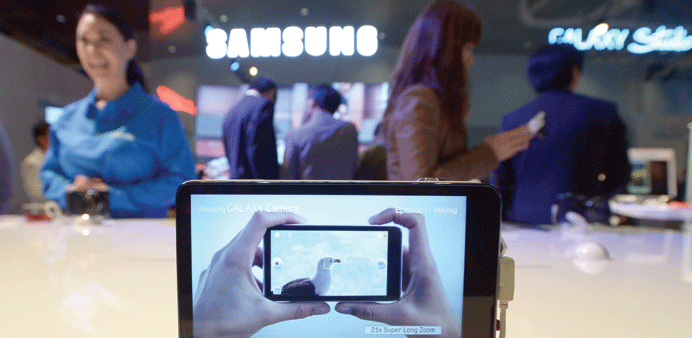Samsung Galaxy camera on display at the 2013 International Consumer Electronics Show (CES) at the Las Vegas Convention Center on January 10 in Nevada.
By Chris O’Brien and Andrea Chang
For a corpse, the International Consumer Electronics Show (CES) was pretty lively.
The 2013 trade show, which ended a four-day run on Friday, attracted a record 3,250 exhibitors and was on pace to match last year’s 156,000 in attendance despite being pronounced all but dead before it started.
The reason for the grim diagnosis by some pundits and analysts was simple. Many of the most influential tech companies in the world didn’t officially participate: Apple Inc, Microsoft Corp, Google Inc, Facebook Inc, Amazon.com Inc
Although this year’s show won’t be remembered for any ground-shaking innovations or jaw-dropping product launches, it did highlight several ways the global technology industry has evolved. From the rise of Samsung Electronics Co to the decline of 3-D as a critical selling point for TVs, the show still offered several important insights.
Technology analyst Rob Enderle published an essay before the show titled: Why CES Will Suck This Year. Much to his surprise, it didn’t.
Enderle noted that in the absence of the major US tech companies, Samsung took centre stage.
The South Korean company is now the leading seller of smartphones and has emerged as one of Apple’s key rivals for mobile supremacy. The company’s pre-show news conference Monday easily drew the biggest line of journalists while its keynote show, which included a guest appearance by former President Bill Clinton, was also impressive.
“Samsung owned the show,” Enderle said.
And when the trade show floor opened on January 8 Tuesday, Samsung’s gigantic booth showcasing its broad range of digital products, including TVs and smartphones, also seemed to tower over other exhibitors. The display even prompted Barclays analyst Ben Reitzes to publish a note to investors suggesting Apple should perhaps rethink its decision not to attend the show.
“The Samsung booth at this year’s show was one of the most crowded and impressive — and the comparison with Apple was palpable in every corner,” he wrote. “This year we couldn’t help thinking more than a few times vs years past, ‘Why doesn’t Apple do this?’”
Enderle echoed that thought when he said that unlike past years, Apple did not seem to “hover like a cloud” over the show.
Instead, following Samsung’s lead, he said the show expanded its international feel as three Chinese companies made big impacts: Lenovo for its laptops and PCs; Huawei for its phones; and Hisense for its phones and TVs. The high-profile trade show also gave floundering companies a chance to lay out their plans and assure the public that things would get back on track.
Executives from BlackBerry maker Research in Motion Ltd met with reporters to promote the company’s long-delayed BlackBerry 10 operating system. The Canadian company is in desperate need of a hit after losing share in the US and other crucial markets to Apple Inc’s iPhone and smartphones running Google Inc’s Android operating system.
Two new phones running BlackBerry 10 will debut January 30. During a demonstration of one of the phones, Richard Piasentin, Research in Motion’s US managing director, showed off a full touch-screen device with front- and rear-facing cameras, HD video, better screen resolution than the iPhone 5 and a faster browser.
“We’re very aware of our market, very aware of our position,” Piasentin said. “We have aggressive goals, but they’re reasonable goals. And before you can be No. 1 you’ve got to be No. 2; before you can be No. 2, you’ve got to be No. 3. And we’re building our plans for the long, slow climb back to the top.”
Meanwhile Panasonic President Kazuhiro Tsuga sought to pump up the struggling Japanese electronics maker, which is grappling with television woes and reported significant losses last year. Tsuga said the company was looking “at what types of options we can make” and warned: “Some businesses, it is necessary to further reduce.”
But he said the company, which introduced new touch-screen Viera smart TVs and a 56-inch ultra-high-definition organic-LED television, was confident that its TV sales would turn around in the coming year and expected to be more cost-competitive on prices.
Still, once the buzz from the show dies down, all television makers face a tough battle trying to persuade consumers to shell out for new ultra-high-definition sets, which are high-priced and lack content. Notably, although the emphasis in recent years had been the addition of 3-D to TVs, not much was said this year about the technology, which has not proved to be a big hit with consumers after years of hype. Instead, TV makers emphasised Internet connectivity, applications and interaction with second-screen devices like phones and tablets.
There were surreal moments too.
Qualcomm Inc had big shoes to fill when it took over the plum pre-show keynote spot from Microsoft Corp, and it delivered with an over-the-top, head-scratching 90 minutes that became the most talked-about part of the convention.
The show was a parade of oddities, starting with an awkward live skit with three actors who talked about what it meant to be “born mobile.” From there, a cast of characters was paraded onto the stage, including none other than Microsoft Chief Executive Steve Ballmer, director Guillermo del Toro, actress Alice Eve, Big Bird, a developer dressed like Big Bird, an electric Rolls-Royce and pop rock group Maroon 5. — Los Angeles Times/MCT



